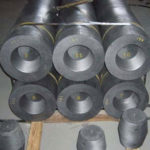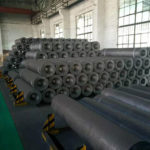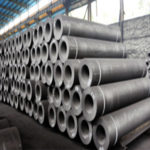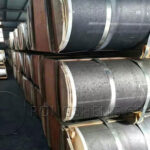The thermal erosion effect of the gas switch arc is the main cause of electrode wear. The graphite electrode evaporates under the action of the arc and has an obvious mass loss after multiple discharges. The gas environment and electrode spacing in the switch are changed, resulting in reduced switching reliability. In order to study the erosion characteristics of graphite electrodes under pulsed arc impact, an arc-electrode energy coupling model was established in the arc root region based on the transient diffusion characteristics of the switching arc and graphite material parameters, and the heat transfer characteristics of the plasma-solid region were obtained. Considering the phase transition characteristics of graphite electrodes, the heating range and critical phase transition point of graphite electrodes under transient heat action are calculated, and the phase transition mechanism of graphite electrodes under transient arc thermal shock is studied. The research results show that the heat flow at the arc-electrode interface is mainly concentrated in the center of the arc contact surface, and the graphite is basically in a heating state at the beginning of the current rise. Under the action of energy accumulation, the graphite transforms into a sublimation state, the heat transfer intensity decays sharply with the radius, and the evaporation area is slightly smaller than the arc radius. The ablation morphology and mass loss of graphite electrodes under five switching conditions were recorded experimentally. The results show that the electrode mass loss is linearly related to the energy deposited by the arc on the electrode surface, which is approximately 0.015 mg/J. The influence of the key parameters of the arc on the electrode mass loss rate is studied to provide data support for delaying electrode loss.
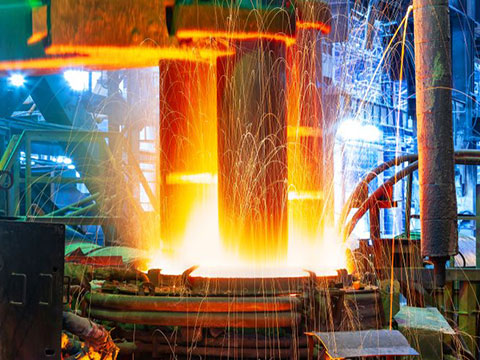
The gas switch is a typical high-current closed switch of the pulse power device, which can meet the extreme parameter requirements of the pulse power supply for high voltage, high peak current, and high current rise rate. For example, the laser inertial confinement fusion device uses a gas switch as an energy control device for the main circuit of the xenon lamp discharge. The gas switch transfers energy through the arc generated by the ionized air between the electrodes. Since the current amplitude of the switch is generally above the kA level, the temperature of the switching arc at this time is as high as tens of thousands of K, and the root of the arc directly contacts the electrode, resulting in damage to the electrode surface. The problem of electrode ablation is a hot spot in the research on this type of switch.
The high-current switch that has been widely used in engineering needs to replace the graphite electrode after 6000~8000 discharges. If the electrodes are not replaced in time, failures such as increased self-flash probability and decreased trigger stability will occur. After the electrode is replaced, the switch needs to be tested for the stability of the pull rod, air tightness verification, etc., to ensure reliability of the switch. Due to the special phase transition characteristics of electrodes, little attention has been paid to the mechanism of graphite loss. This study aims to reveal the evaporation mechanism of graphite electrodes in the switch cavity, explore the key factors affecting electrode ablation, and provide a feasible reference for delaying electrode loss.
Conclusion
The arc magnetohydrodynamic model under the condition of pulse discharge is established, and the transient thermodynamic response of the graphite electrode surface under arc shock is studied. Using the typical pulse discharge current waveform of 30kA/2.3ms, the arc temperature field change characteristics, electrode surface heat flux intensity, and electrode-arc interface energy characteristics were calculated. The surface temperature distribution and evaporation characteristics of graphite electrodes at each moment of pulse discharge are obtained, and the mass loss characteristics of graphite electrodes are verified and summarized through experiments.
(1) The calculation method based on magnetohydrodynamics has high simulation accuracy for the diffusion characteristics of the switching arc. Under the pulse current condition of 30kA/2.3ms, the ablation radius of the arc root is about 10mm, which is basically consistent with the simulation results. The dynamic change of the arc area under the condition of pulse current excitation is relatively complicated, and it is difficult to find the linear relationship in value. Using multiphysics simulation software for transient solutions is a more reliable method.
(2) The ablation of graphite is mainly caused by the thermodynamic accumulation effect on the electrode surface. During the pulse discharge process, the heat flux intensity on the electrode surface first increases and then decreases, but the energy absorbed by the electrode from the arc continues to increase. With the expansion of the arc radius, the temperature rise area of the electrode increases continuously. When the electrode temperature reaches the critical point of phase transition, graphite escapes from the electrode surface in the form of evaporation, and the evaporation at the center of the arc root is significantly higher than that at the edge. At the falling edge of the pulse current, since the electrode temperature at the arc root is already at the phase transition critical temperature, although the heat flow at the arc root decreases at this stage, the electrode still has an evaporation increment.
(3) The evaporation rate of the graphite electrode is mainly affected by the temperature state of the electrode and the instantaneous heat flux intensity at the root of the arc. This theory can be used to explain the reasons for the differences in electrode ablation rates in different discharge atmospheres. In the N2 background gas environment, the relationship between the escape rate of graphite and the arc energy deposition is 0.015mg/J.

